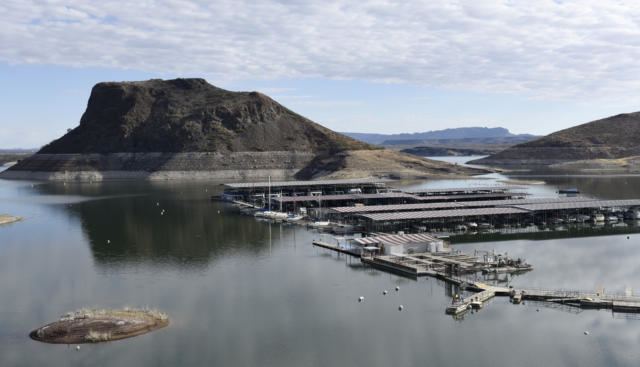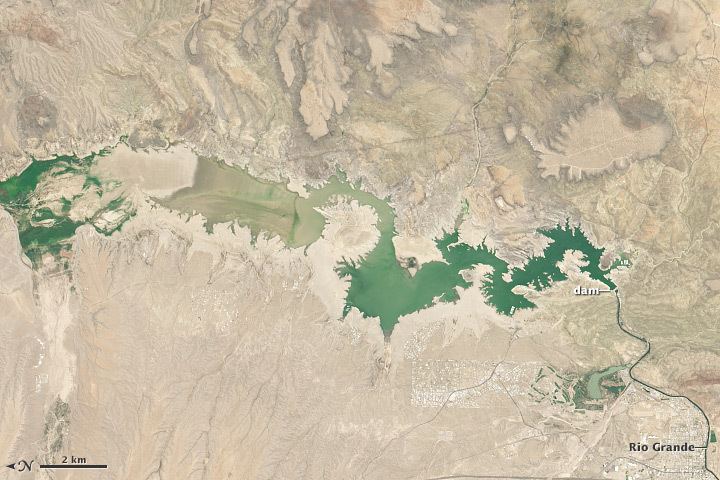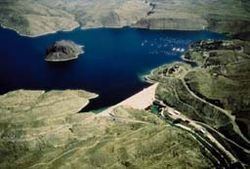Primary inflows Basin countries United States Surface elevation 1,345 m | Primary outflows Rio Grande Area 147.7 km² Length 64.37 km Islands Elephant Butte | |
Surface area 36,500 acres (14,800 ha) Similar Elephant Butte Dam, Cochiti Dam, Caballo Dam, Santa Rosa Lake State Park, El Vado Dam | ||
Float tube fishing at elephant butte reservoir
Elephant Butte Reservoir is a reservoir on the Rio Grande in the U.S. state of New Mexico, 5 miles (8.0 km) north of Truth or Consequences. This reservoir is the 84th largest man-made lake in the United States and the largest in New Mexico by total surface area. It is the only place in New Mexico where one can find pelicans perched on or alongside the lake. There are also temporary US Coast Guard bases stationed at Elephant Butte. It is impounded by Elephant Butte Dam and is the largest reservoir in New Mexico by peak volume. The reservoir is also part of the largest state park in New Mexico, Elephant Butte Lake State Park.
Contents
- Float tube fishing at elephant butte reservoir
- Shallow water catfish at elephant butte reservoir
- History and dam constructionEdit
- References
The reservoir is part of the Rio Grande Project, a project to provide power and irrigation to south-central New Mexico and west Texas. It was filled starting between 1915 and 1916.

The reservoir can hold 2,065,010 acre feet (2.54715×109 m3) of water from a drainage of 28,900 square miles (74,850 km²). It provides irrigation to 178,000 acres (720 km²) of land.

The name "Elephant Butte" refers to a volcanic core similar to Devils Tower in Wyoming. It is now an island in the lake. The butte was said to have the shape of an elephant lying on its side.

Fishing is a popular recreational activity on the reservoir, which contains striped bass, white bass, largemouth bass, crappie, walleye and catfish.

Shallow water catfish at elephant butte reservoir
History and dam constructionEdit
Elephant Butte Dam, constructed between 1911 and 1916, with the reservoir fill started in 1915, was a major engineering feat in its day. The enormous concrete dam is the major feature of the Elephant Butte National Register Historic District. New Mexico State Parks operates a visitor center that contains information on the construction of the dam. At the time of its construction, the dam was the largest irrigation dam ever built with the exception of the Aswan Dam in Egypt.
A large construction community sprang up, which included worker camps, railways, water tanks, cableway systems, and the former administration building of the Bureau of Reclamation. The "camps" housed American and Mexican workers throughout the construction of the dam. Many of the former camps ended up under the reservoir itself, while others disappeared altogether.
The former administration building of the Bureau of Reclamation still stands as a bed and breakfast facility, and, along with other structures of the time, are listed in the National Register of Historic Places. When the lake falls over 10 meters (30 feet) below maximum capacity, the ruins of an old machine shop rise out of the water. Located near the south-east shore, this 3000 square-foot concrete structure was once believed to be the remnants of the old field hospital that served the frequently injured dam construction crew. That building is located further upstream in the aptly named 'Hospital Canyon'. Plans are underway to make the machine shop ruins a scuba destination in years of high water-level.
